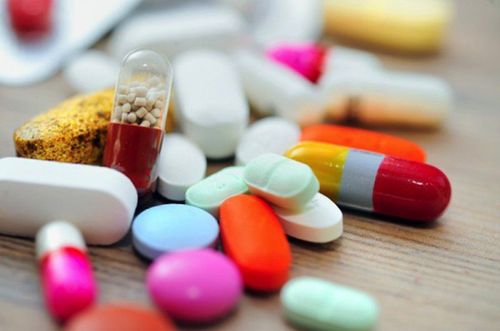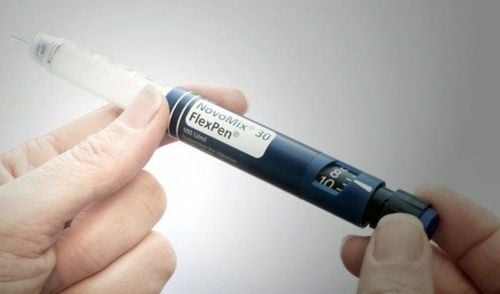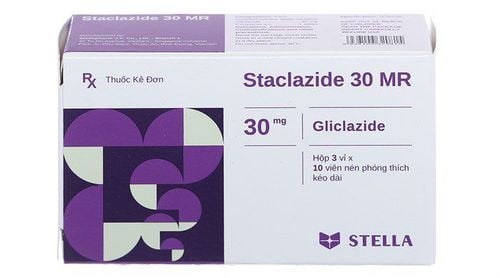This is an automatically translated article.
Mixtard 30 medicine contains the main ingredient is Insulin human (rDNA) 30mg, which is effective in the treatment of diabetes. The drug is prepared in the form of a suspension for injection contained in a pre-filled syringe and has an opaque white color.
1. What is Mixtard 30? Ingredients of Mixtard 30
Mixtard 30 is a drug with the treatment of diabetes. Mixtard 30 ingredients include:
Human insulin (30% soluble insulin and 70% insulin isophane), rDNA (produced by recombinant DNA technique in the cells of Saccharomyces cerevisiae). In addition, there are a number of other excipients with a sufficient amount of 10ml. Dosage form: Mixtard 30 is prepared in the form of a suspension for injection.
Drug group: Drugs belonging to the group of treating diabetes.
2. Effects of the drug Mixtard 30
2.1. Indications for use of Mixtard 30 for the treatment of type I diabetes mellitus (insulin dependent diabetes mellitus). Treatment of type II diabetes mellitus when treatment with synthetic antidiabetic drugs is no longer effective. Stabilize diabetes initially and especially for emergency cases of diabetes. Children are thin and weak, poor appetite, malnourished, vomiting a lot and blood sugar metabolism disorders (usually glucose infusion combined with insulin). Induce insulin shock to treat mental illness (create sudden and strong hypoglycemia). 2.2. Pharmacodynamics of the drug Mixtard 30 The drug Mixtard 30 is used in the treatment of diabetes mellitus. Insulin and insulin analogues injectable, intermediate-acting combined with rapid-acting, insulin (human).
The effect of Mixtard 30 in lowering blood glucose of insulin is due to easier glucose absorption after insulin binds to receptors in muscle and fat cells, and inhibits glucose production. from the liver.
2.3. Pharmacokinetics of Mixtard 30 Mixtard is a dual-acting insulin. The effect begins within 1⁄2 hours, reaches its maximum effect within 2-8 hours, and lasts 24 hours. Absorption: Peak plasma concentrations of rapid-acting insulin are achieved within 1.5 - 2.5 hours of subcutaneous administration. Distribution: Not strongly bound to plasma proteins, except for circulating anti-insulin antibodies (if present. Metabolism: Human insulin has been reported to be degraded by insulin protease or insulin-degrading enzymes and possibly by protein disulfide isomerase Elimination: The terminal half-life is determined by the rate of absorption from the subcutaneous tissue.Therefore, the terminal half-life (t1/2) is considered a measure of absorption. than the per second elimination of insulin from plasma (blood insulin has a t1/2 of a few minutes) Tests have shown a terminal half-life of about 5 - 10 hours 2.4. Effect of Mixtard 30 On glucose metabolism: Mixtard 30 has the main ingredient of insulin, which reduces blood sugar because insulin helps glucose to easily enter cells, especially liver, muscle and adipose tissue cells. : Increases lipid synthesis and storage in the liver, prevents lipolysis and inhibits the production of ketones by inhibiting the activity of sensitive lipases. It inhibits the hormone, reducing the concentration of free fatty acids and glycerol in the blood plasma. On protid metabolism: promote protein assimilation by making amino acids easier to penetrate into cells to synthesize proteins. Especially in the vascular wall, insulin participates in the formation of structural glycoproteins, so if insulin deficiency causes the condition of the vessel wall to be vulnerable.
3. Side effects of the drug Mixtard 30
Hypoglycemia is a common undesirable effect of treatment with Mixtard 30 or insulin. Signs of hypoglycemia often come on suddenly and include:
Sweating; Blue and cold skin; Restlessness, tremors, feelings of anxiety, unusual tiredness; Psychiatric disturbances such as confusion, difficulty concentrating, lethargy, intense hunger; Temporary loss of vision; Headache, nausea, nervousness and palpitations. Severe hypoglycemia can lead to unconsciousness, can cause temporary or permanent impairment of brain function, or can even be life-threatening. When insulin therapy is initiated, edema and refractive abnormalities may occur when insulin therapy is initiated. When treated with Mixtard 30 this side effect is usually transient and disappears quickly.
Some other undesirable effects may be encountered during treatment with Mixtard 30:
Local hypersensitivity reactions such as redness, heat, swelling and itching at the injection site. Systemic hypersensitivity reactions such as generalized rash, pruritus, sweating, gastrointestinal disturbances, angioedema, dyspnea, palpitations and hypotension. Lipodystrophy can be seen at the injection site caused by not changing the site in the injection site or injecting the same site for many days.
4. Usage and dosage of the drug Mixtard 30
4.1. How to use Mixtard 30 Mixtard 30 is administered by subcutaneous injection. Insulin suspension should never be used intravenously. About how to inject Mixtard 30, it is important to pay attention to the following points:
Mixtard is injected under the skin into the thigh area or abdominal wall, buttock or deltoid muscle can also be injected. Subcutaneous injection into the abdominal wall ensures faster absorption than injection into other injection sites. Injections into skin folds are pinched to minimize the risk of unintended intramuscular injection. The needle should be kept under the skin for at least 6 seconds to ensure that the entire insulin dose has been administered. Change injection sites within the same injection site to minimize the risk of lipodystrophy. Mixtard is packaged in a box with a detailed instruction sheet for users to follow. As a precaution, you should always carry a spare insulin pen in case the FlexPen is lost or damaged. 4.2. Dosage of Mixtard 30 Mixtard 30 is a dual-acting insulin. This is a two-phase formulation of rapid-acting insulin and long-acting insulin. Premixed insulin is usually given once or twice daily when a quick onset of action, along with a longer duration of action, is required. Dosage is individual and determined according to individual needs. The average individual's insulin requirements range from 0.3 to 1.0 IU/kg/day. Daily insulin requirements may be higher in people with insulin resistance (eg, during puberty or due to obesity) and lower in people who produce excess endogenous insulin. You should pay attention, prepare a main meal or a carbohydrate snack within 30 minutes of each injection. Note on therapeutic dose: The above dosage is for reference only. The specific treatment dose depends on the condition and severity of the disease of each person. For the right therapeutic dose, you need to consult your treating doctor or medical professional.
4.3. In case of overdose/missing dose In case of overdose: hypoglycaemia may develop through successive episodes if doses too high for the patient's insulin requirements:
Mild hypoglycaemic phase, physician Treatment with oral glucose or sugary products may be indicated. Therefore, people with diabetes are advised to carry sugary products with them at all times. During severe hypoglycemia, when unconscious, the doctor may prescribe glucagon (0.5 - 1 mg) IM or subcutaneous injection because a person has been instructed on how to administer the drug or use injectable glucose. intravenous infusion by a healthcare professional. Intravenous glucose must be administered if no response to glucagon is observed within 10 to 15 minutes. When regaining consciousness, it is necessary to give food containing carbohydrates to prevent recurrence. In case of missed dose: If you miss a dose of Mixtard 30, take it as soon as possible. However, if it is almost time for the missed dose, skip the missed dose and use the next dose at the scheduled time. Note that absolutely do not use the drug at a dose twice the prescribed dose.
5. Mixtard 30 . drug interactions
Some therapeutic drugs interact with glucose metabolism. The following substances may reduce a person's insulin requirements
Oral diabetes medications; monoamine oxidase inhibitors (MAOIs); Non-selective beta-blockers; Angiotensin-converting enzyme (ACE) inhibitors, salicylates, anabolic steroids and sulphonamides. The following substances may increase the user's insulin requirements:
Oral contraceptives, thiazides, glucocorticoids, thyroid hormone, sympathomimetic, growth hormone and danazol. Beta-blockers may mask the signs of hypoglycemia and delay recovery from hypoglycemia. Lanreotide may increase or decrease the need for insulin. Alcohol can increase or decrease the need for insulin.
6. Some notes when using Mixtard 30
Before using Mixtard 30 you need to carefully read the instructions for use and refer to the information below.
6.1. Contraindications when using Mixtard 30 Drug Mixtard 30 is contraindicated in the following cases:
Hypersensitivity or sensitivity to the main active ingredient or to any of the excipients of the drug. People with low blood sugar. 6.2. Precautions while using Mixtard 30 The conversion from insulin of animal origin to recombinant drug may require a change in the therapeutic dose due to the different response to the organism. Usually, the treating doctor will reduce the dose in this case. Inadequate or intermittent drug therapy, especially in type 1 diabetes, can lead to hyperglycemia. In type 1 diabetes, untreated hyperglycemia eventually leads to diabetic ketoacidosis, potentially fatal. Ability to drive and use machines: A person's ability to concentrate and react may be impaired as a result of hypoglycemia. This can be dangerous while driving or operating machinery. Use with caution in people with Cushing's syndrome, hyperthyroidism or adrenal myeloma. Pregnancy: There are no restrictions on the treatment of diabetes in pregnant women, because insulin is a protein that does not cross the placental barrier. Enhanced blood sugar control and monitoring of pregnant women with diabetes are recommended throughout pregnancy and during pregnancy. The need for insulin normally decreases during the first trimester of pregnancy and will gradually increase during the second and third trimesters. After delivery, insulin requirements quickly return to pre-pregnancy levels. Lactation: There are no restrictions on the use of the drug during lactation. Insulin therapy for nursing mothers poses no risk to the baby. However, your doctor may have to adjust your dose, your daily regimen, or both. Mixtard 30 contains the main ingredient is Insulin human (rDNA) 30mg, which is effective in the treatment of diabetes. To ensure effective use, patients need to carefully read the instructions or consult a doctor or pharmacist.
Follow Vinmec International General Hospital website to get more health, nutrition and beauty information to protect the health of yourself and your loved ones in your family.
Please dial HOTLINE for more information or register for an appointment HERE. Download MyVinmec app to make appointments faster and to manage your bookings easily.













